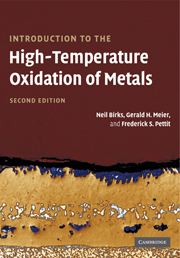Book contents
- Frontmatter
- Contents
- Acknowledgements
- Preface
- Introduction
- 1 Methods of investigation
- 2 Thermodynamic fundamentals
- 3 Mechanisms of oxidation
- 4 Oxidation of pure metals
- 5 Oxidation of alloys
- 6 Oxidation in oxidants other than oxygen
- 7 Reactions of metals in mixed environments
- 8 Hot corrosion
- 9 Erosion–corrosion of metals in oxidizing atmospheres
- 10 Protective coatings
- 11 Atmosphere control for the protection of metals during production processes
- Appendix A Solution to Fick's second law for a semi-infinite solid
- Appendix B Rigorous derivation of the kinetics of internal oxidation
- Appendix C Effects of impurities on oxide defect structures
- Index
- References
7 - Reactions of metals in mixed environments
Published online by Cambridge University Press: 05 June 2012
- Frontmatter
- Contents
- Acknowledgements
- Preface
- Introduction
- 1 Methods of investigation
- 2 Thermodynamic fundamentals
- 3 Mechanisms of oxidation
- 4 Oxidation of pure metals
- 5 Oxidation of alloys
- 6 Oxidation in oxidants other than oxygen
- 7 Reactions of metals in mixed environments
- 8 Hot corrosion
- 9 Erosion–corrosion of metals in oxidizing atmospheres
- 10 Protective coatings
- 11 Atmosphere control for the protection of metals during production processes
- Appendix A Solution to Fick's second law for a semi-infinite solid
- Appendix B Rigorous derivation of the kinetics of internal oxidation
- Appendix C Effects of impurities on oxide defect structures
- Index
- References
Summary
Introduction
Study of the behaviour of pure metals and alloys in single oxidant systems, at high temperature, is vital for developing an understanding of the general mechanisms involved in oxidation and scaling reactions. In almost all cases where alloys are used commercially at high temperature, in gas turbines, in heat exchangers, or structurally in furnaces etc., they are exposed to complex atmospheres that contain a variety of gas species. These situations are complex and demand a thorough understanding of the underlying thermodynamics and kinetic principles to describe the reactions and the mechanisms by which they proceed. In such cases the aim is not simply to explain and understand how the reaction proceeds, but to go a step further and predict how the reactions might be prevented or contained.
In fact, apart from controlled laboratory atmospheres, the gas is always complex in the multi-oxidant sense since even nitrogen in air can form nitrides with some alloy systems in addition to the oxides formed by the oxygen. This is seen particularly in alloys containing metals such as chromium, titanium, and niobium, where the formation of nitrides in air atmospheres interferes with the ‘simple’ oxidation situation that is observed when using pure oxygen, or oxygen–argon mixtures.,
Air–H2O and air–CO2 atmospheres
The presence of water vapour and carbon dioxide in air and, to a greater extent, in atmospheres derived from the combustion of fossil fuel, has been found to increase the observed reaction rate of steels and other metals noticeably.
- Type
- Chapter
- Information
- Introduction to the High Temperature Oxidation of Metals , pp. 176 - 204Publisher: Cambridge University PressPrint publication year: 2006
References
- 4
- Cited by

